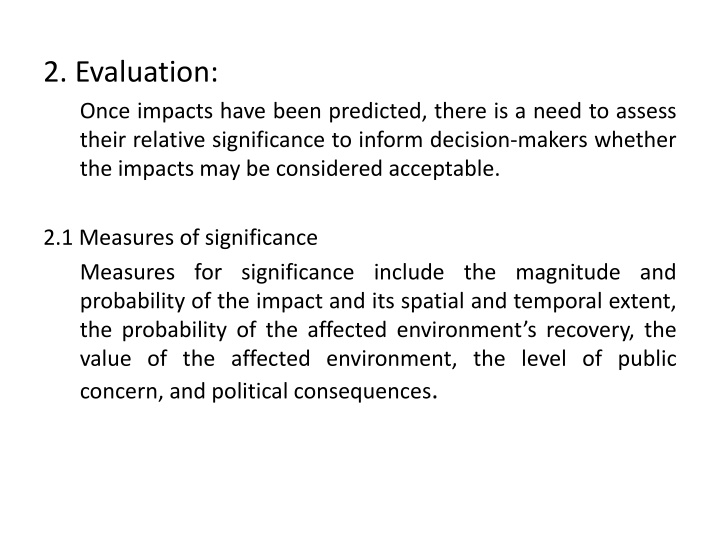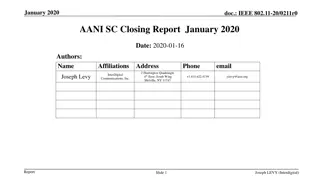
Evaluating Impact Significance for Informed Decision-making
Learn about the evaluation of impacts to determine their relative significance for decision-makers. Measures and methods like scoring and weighting are used to assess environmental significance and inform mitigation strategies. Explore the importance of assessing impacts on health, welfare, environment, and public concern to make informed decisions.
Download Presentation

Please find below an Image/Link to download the presentation.
The content on the website is provided AS IS for your information and personal use only. It may not be sold, licensed, or shared on other websites without obtaining consent from the author. If you encounter any issues during the download, it is possible that the publisher has removed the file from their server.
You are allowed to download the files provided on this website for personal or commercial use, subject to the condition that they are used lawfully. All files are the property of their respective owners.
The content on the website is provided AS IS for your information and personal use only. It may not be sold, licensed, or shared on other websites without obtaining consent from the author.
E N D
Presentation Transcript
2. Evaluation: Once impacts have been predicted, there is a need to assess their relative significance to inform decision-makers whether the impacts may be considered acceptable. 2.1 Measures of significance Measures for significance include the magnitude and probability of the impact and its spatial and temporal extent, the probability of the affected environment s recovery, the value of the affected environment, the level of public concern, and political consequences.
Environmental significance is a judgment made by the Authority and takes into consideration the following factors: the extent and consequences of impacts on the health, welfare, comfort or amenity of people. the environmental value of the area affected. the extent to which the proposal implements the principle of sustainability. the ability of decision-making authorities to place conditions on the proposals to ensure required environmental outcomes are achieved. the likely level of public interest.
2.2 Scoring and weighting methods Scoring may use quantitative or qualitative scales, according to the availability of information consideration. An example of how different levels of impact (in this example noise) can be scored in different systems is shown below. These systems seek to standardize the impact scores for purposes of comparison. Where quantitative data are not available, ranking of alternatives may use other approaches, for example using letters (A, B, C, etc.) or words (not significant, significant, very significant). on the impact under Weighting seeks to identify the relative importance of the various impact types for which scores of some sort may be available
A comparison of different scoring systems Alternative Method Basis of Scour A B C D Ratio 65 62 71 75 Absolute L10dBA measure Interval 0 -3 +6 +10 Difference in L10dBA using alternative A as base Ordinal B A C D Ranking according to ascending value of L10dBA Binary 0 0 1 1 0=less than 70L10dBA 1=70L10dBA or more
Weighting and scoring Scheme (A) Scheme (B) Impact Weight (W) Score (A) (AW) Score (B) (BW) Noise 2 5 10 1 2 Loss of flora 5 1 5 4 20 Air pollution 3 2 6 2 6 Total 21 28
3. Mitigation: 3.1 Mitigation measures Mitigation measures, as outlined in UK guide: a. Site planning. b. Technical measures, e.g.: Process selection. Recycling. Pollution control and treatment. Containment (e.g. building of storage vessels)
c. Aesthetic and ecological measures, e.g.: Landscape. Tree plantings. Measure to preserve particular habitats. Recording of archaeological sites. Measures to safeguard historic buildings or sites.
The prediction and evaluation of impacts may reveal such significant adverse effects that the only effective mitigation measure may be to reject the proposal. More normal, situation would be to modify the development action to avoid various impacts. Examples of methods to avoid impacts include: the control of solid and liquid wastes by recycling on site or by removing them from the site for environmentally sensitive treatment elsewhere. the use of a designated lorry route, and day-time working only, to avoid disturbance to village communities from construction lorry traffic and from night construction work. the minimal use of toxic substances, to avoid impacts on local ecosystems.
Some adverse effects may be less need to be avoided completely. Examples of methods to reduce adverse effects include: the sensitive design of structures, using simple profiles, local materials and muted colors, to reduce the visual impact of a development. the use of construction-site hostels, and coaches for journeys to work to reduce the impact on the local housing market, and on the roads, of a project employing many workers during its construction stage. the planting of cover crops to reduce erosion of soil.
Some adverse effects cannot be reduced. In such cases, it may be necessary to compensate people for adverse effects. For example: for the loss of public recreational space or a wildlife habitat, compensation would be the provision of land for recreation. for the loss of privacy, quietness and safety in houses next to a new road, compensation would be the provision of sound insulation and/or the purchase by the developer of badly affected properties. Mitigation measures must be planned in an integrated and fashion to ensure that they are effective, that they do not conflict with each other and that they do not merely shift a problem from one medium to another.
Example of a section of a summary table for impacts and mitigation measures Impact Mitigation measure(s) Level of significanc e After Mitigation 400 acres of agricultural land would be lost from the county to accommodate the petrochemical plant. The only full mitigating measure for this impact would be to abandon the project. SU Additional lorry and car traffic on the adjacent hilly section of the motorway will volumes by 10 20 per cent above those predicted on the basis of current trends. A lorry lane on the motorway, funded by the developer, will help to spread the volume, but effects may be partial and short-lived. SU increase traffic The movement species from the hilly areas to the east of the site to the wetlands to the west of the site. project would most block terrestrial the A wildlife corridor should be developed and maintained along the entire length of the existing stream which runs through the site. The width of the corridor should be a minimum of 75 ft. The stream bed should be cleaned of silt and enhanced through the construction of occasional pools. The buffer zone should be planted with native riparian vegetation, including sycamore and willow. LS of Note: SU=Significant unavoidable impact; LS=Less than significant impact.









